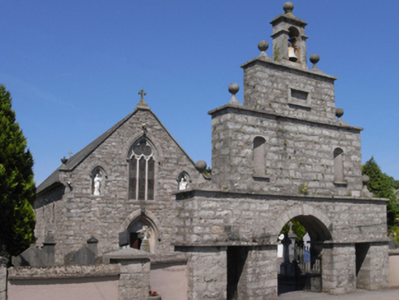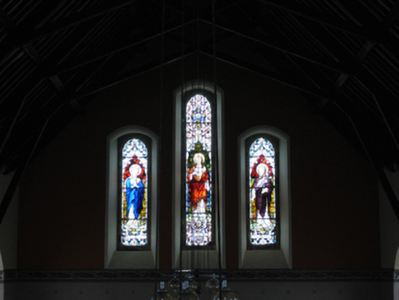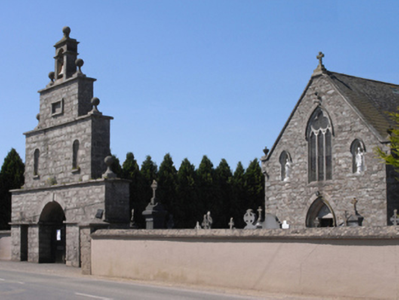Survey Data
Reg No
15701819
Rating
Regional
Categories of Special Interest
Architectural, Artistic, Historical, Social, Technical
Original Use
Church/chapel
In Use As
Church/chapel
Date
1855 - 1865
Coordinates
283634, 139390
Date Recorded
28/08/2007
Date Updated
--/--/--
Description
Detached five-bay double-height single-cell Catholic church, built 1859-60; dated 1859, on a rectangular plan. Renovated, ----, with sanctuary reordered. Pitched slate roof with clay ridge tiles, cut-granite "saddleback" coping to gables on urn-topped "Cavetto"-detailed beaded kneelers with Cross finials to apexes, and cast-iron rainwater goods on slightly overhanging slate or stone flagged eaves retaining cast-iron downpipes. Repointed coursed rubble granite walls originally rendered, ruled and lined on cement rendered chamfered plinth with hammered granite flush quoins to corners; rendered, ruled and lined surface finish (west). Pointed-arch window openings with cut-granite sills, and cement rendered "bas-relief" surrounds framing storm glazing over fixed-pane fittings having stained glass margins centred on leaded stained glass panels. Lancet "Trinity Window" to chancel (west), cut-granite block-and-start surrounds having chamfered reveals with hood mouldings over framing storm glazing over fixed-pane fittings having margins centred on leaded stained glass panels. Pointed-arch door opening to entrance (east) front, cut-granite block-and-start surround having chamfered rebated reveals with hood moulding over on label stops framing replacement diagonal timber boarded or tongue-and-groove timber panelled double doors. Pointed-arch window opening to gable with cut-granite mullions, and date stone-inscribed ("1859") cut-granite block-and-start surround having chamfered reveals with hood moulding over on label stops framing iron mesh storm panels over fixed-pane fittings having leaded stained glass panels. Interior including vestibule (east); square-headed door opening into nave with glazed timber panelled double doors having sidelights on panelled risers below overlight; full-height interior open into roof with choir gallery (east) below stained glass memorial "East Window" (1912), carpeted aisles between Maltese Cross-detailed timber pews, paired Gothic-style timber memorial stations (1906) between stained glass memorial windows (----), cut-white marble Gothic-style wall monument (ob. 1913) with cut-white marble scroll wall monument (ob. 1924), stepped dais to sanctuary (west) reordered, ----, with pierced quatrefoil-detailed cut-veined white marble Gothic-style altar below stained glass memorial "Trinity Window" (1898), and exposed braced scissor truss timber roof construction on cut-granite beaded corbels with wind braced rafters to ceiling. Set in landscaped grounds.
Appraisal
A church erected under the aegis of Reverend Myles Doran PP (1808-90) representing an integral component of the mid nineteenth-century ecclesiastical heritage of County Wexford with the architectural value of the composition, one evoking favourable comparisons with the contemporary Catholic Church of Saint John the Baptist (1858), Caim (see 15701914), confirmed by such attributes as the compact rectilinear "barn" plan form, aligned along an inverted liturgically-correct axis; and the slender profile of the openings underpinning a "medieval" Gothic theme with the chancel defined by an elegant "Trinity Window". Having been well maintained, the elementary form and massing survive intact together with substantial quantities of the original fabric, both to the exterior and to the interior reordered (----) in accordance with the liturgical reforms sanctioned by the Second Ecumenical Council of the Vatican (1962-5) where contemporary joinery; vibrant stained glass; wall monuments; and the Quigley Memorial "Trinity Window" (ob. 1898), all highlight the artistic potential of the composition: meanwhile, an exposed timber roof construction pinpoints the engineering or technical dexterity of a church forming part of a neat self-contained group alongside an eye-catching "Triumphal Gateway" (see 15701820) with the resulting ensemble making a pleasing visual statement in a rural village street scene.





